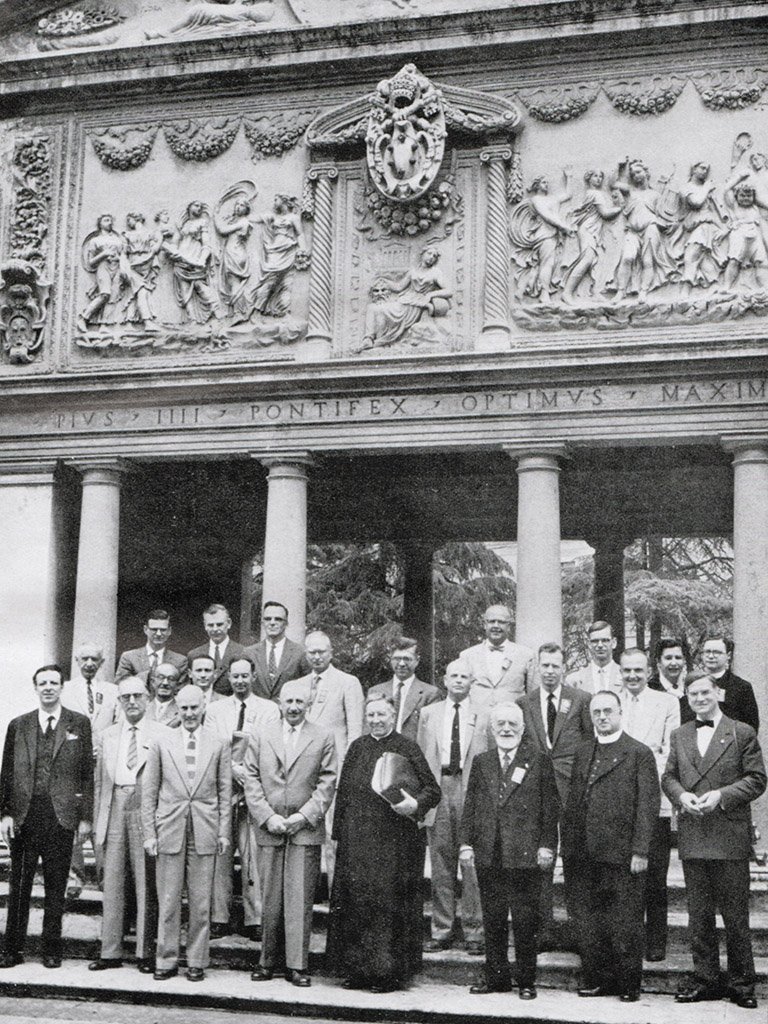
Workshop on Stellar Populations

In 1957 the Pontifical Academy of Sciences and the Specola Vaticana co-sponsored a workshop on the topic of stellar populations, an then-new topic that had implications not only for our understanding of how stars evolve but ultimately about nucleosynthesis and the age of the universe. The fact that older stars were of a different chemical population than younger stars supported the idea of an evolving universe, especially the model that has come to be known as the “Big Bang”.
Attending this meeting were a number of the most important astrophysicists of the age [guide photo available]:
a. Daniel O’Connell SJ (1896 – 1982) director of the Vatican Observatory 1952 – 1970
b. Giuseppi Armellini (1887 – 1958) Studied planetary formation, head of Campidoglio/Monte Mario observatory
c. Walter Baade (1893 – 1960) By observing stars in the Andromeda Galaxy he invented our present Population I and II system; his observations of Cepheid variables in that galaxy recalibrated our understanding of the size of the universe
d. Adriaan Blaauw (1914 – 2010) Founder and first director of European Southern Observatory; studied high velocity stars
e. Hermann Brück (1905 – 2000) Refounder of Dunksink Observatory, Ireland; Astronomer Royal for Scotland 1957 – 1975. (He fled Nazi Germany to work at the Vatican Observatory in 1936)
f. Daniel Chalonge (1895 – 1977) A founder of the Institut d’astrophysique de Paris, studied stellar photometry, inventor of the Chalonge microphotometer
g. William Fowler (1911 – 1995) Won the Nobel prize in Physics in 1983 for his theories of how elements are made by nuclear reactions inside stars
h. Otto Heckmann (1901 – 1983) First director of the European Southern Observatory; expert in cosmology
i. George Herbig (1920 – 2013) Discoverer of “Herbig-Haro” objects, a particular type of young star
j. Fred Hoyle (1915 – 2001) Worked with Fowler on theories of how elements are formed in stars; invented the term “Big Bang”
l. Georges Lemaître (1894 – 1966) In 1928, Fr. Lemaître proposed the cosmological theory that has come to be known as the “Big Bang”
m. Bertil Lindblad (1895 – 1965) Explained certain orbital resonances (“Lindblad resonances”) and details of the rotation of galaxies; such work has ultimately led to the detection of “dark matter”
n. William Morgan (1906 – 1994) Developed stellar classification system, proved the existence of spiral arms in the Milky Way
o. Jason Nassau (1893 – 1965) Expert in galactic structure.
p. Jan Oort (1900 – 1992) Determined the existence of a distant cloud of comets now called the Oort Cloud
q. Ed Salpeter (1924 – 2008) Applied nuclear theory to the formation of elements in stars; described how black holes provide the energy of active galactic nuclei
r. Allan Sandage (1926 – 2010) First accurate measurement of Hubble Constant, discoverer of quasars
s. Martin Schwarzschild (1912 – 1997) One of the first astrophysicists to apply electronic computer methods for modeling the evolution of stars
t. Lyman Spitzer (1914 – 1997) An expert on interstellar dust, he first proposed telescopes in space; the Spitzer Space Telescope is named for him
u. Bengt Strömgren (1908 – 1987) Determined relative abundances of helium and other elements in stars; devised the Strömgren system of photometric filters
v. A. David Thackeray (1910 – 1978) Estimated size and age of universe via variables in Magellanic Clouds; discovered Thackeray’s Globules (stellar formation region)
w. Patrick Treanor SJ (1920 – 1978) who studied the metal content of stars; he would become the director of the Vatican Observatory, 1970 – 1978
x. Pietro Salviucci (1936 – 1973) Chancellor of the Pontifical Academy of Sciences
z. V. Préobrajenski, secretary of the Pontifical Academy
Note that all but one of the scientists are northern European-origin men (plus the chancellor of the Pontifical Academy). In part this reflects the state of the economy in the post-WW2 era, when few nations could support astronomical research; but still, the lack of diversity is striking.
